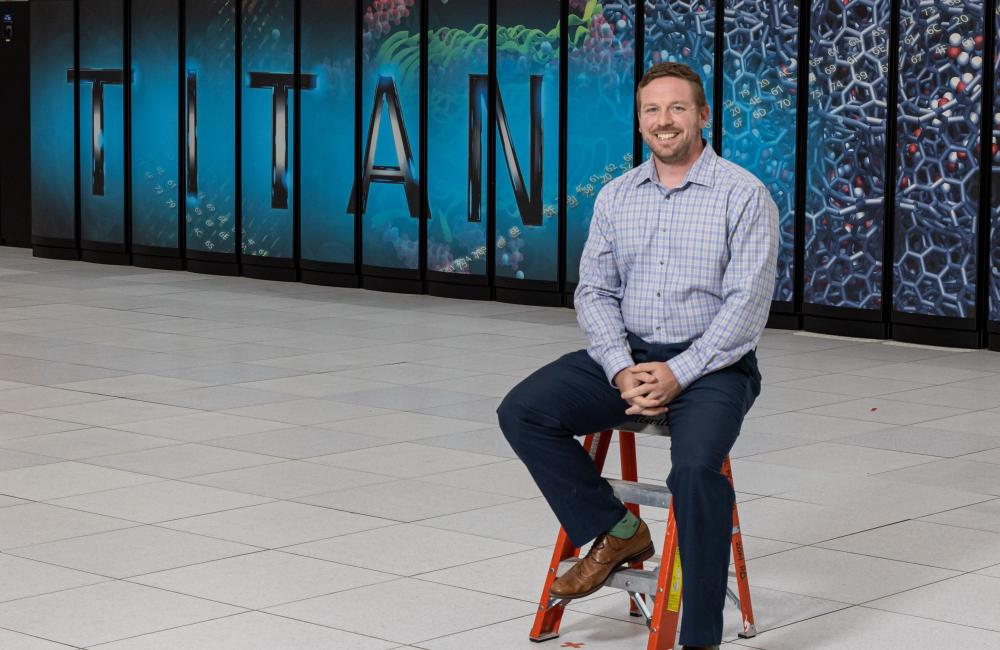Stephen McNally kept Titan running for hundreds of users as National Center for Computational Sciences operations manager. Image credit: Carlos Jones, ORNL
A long-running supercomputer with tremendous impact
ORNL’s Titan supercomputer was decommissioned last August and disassembled for recycling. Its space at the Oak Ridge Leadership Computing Facility is being retrofitted for ORNL’s first exascale supercomputer, Frontier, which is slated for delivery in 2021 and will be capable of quintillion calculations a second.
Performing up to 27 quadrillion calculations per second, Titan ranked as one of the world’s top 10 fastest supercomputers from its debut as No. 1 in 2012 until June 2019. In its time, Titan served hundreds of research teams around the world working on urgent scientific challenges, providing, for instance, unprecedented simulations of polymers and enzymes critical to the production of cellulosic ethanol, physics-based earthquake hazard models for Southern California and particle-scale plasma simulations for future fusion reactors.
ORNL and OLCF staff said their goodbyes to Titan as they gathered in the data center to film HPC systems administrator Don Maxwell shutting down the machine for the last time in August 2019. In the video, the high-pitched whir of Titan’s nearly 300,000 CPU cores and 18,688 GPUs fades to silence. ORNL Lab Director Thomas Zacharia shared through social media: “Very proud of the tremendous impact supercomputer Titan has had on the scientific community.”
In the weeks following Titan’s shutdown, electricians safely disconnected the 9 megawatt-capacity system, and staff from manufacturer Cray disassembled and recycled Titan’s electronics and metal components and cabinets.
“The reality is, in electronic years, Titan is ancient,” said Operations Manager Stephen McNally in summer 2019. “Think of what a cell phone was like seven years ago compared to the cell phones available today. Technology advances rapidly, including supercomputers. …
“People ask why we can’t split up Titan and donate sets of cabinets to different research groups, but the answer is that it’s simply not worth the cost to a data center or university of powering and cooling even fragments of Titan. Titan’s value lies in the system as a whole.”
A new generation of supercomputer
When planning for Titan began in 2009, the high-performance computing community had just the year before passed the petascale barrier, achieving more than a quadrillion calculations per second on two DOE supercomputers: Roadrunner at Los Alamos National Laboratory and Jaguar at ORNL.
However, science never sleeps, and the OLCF was already planning its next supercomputer. This second-generation petascale system would need to be about 10 times more powerful than Jaguar—which had been upgraded to a peak speed of 2.6 petaflops—to meet the growing computational needs of researchers working on complex problems in materials science, biology, physics and other research domains.
Even more challenging than increasing speed, the OLCF’s next supercomputer would need to meet DOE goals for cost and energy efficiency, meaning it would need to do 10 times the work while consuming roughly the same amount of energy.
Enter Titan, a new generation of supercomputer with a revolutionary architecture that combined 16-core central processing units, or CPUs, and NVIDIA Kepler accelerated processors known as graphics processing units, or GPUs.
The GPUs tackled computationally intensive math problems while the CPUs efficiently directed tasks. When the system debuted at No. 1 in 2012, Titan delivered 10 times the performance of Jaguar with a peak performance of 27 petaflops.
“Choosing a GPU-accelerated system was considered a risky choice,” OLCF Program Director Buddy Bland said. “A DOE independent project review committee insisted that we demonstrate that our users would be able to effectively use Titan for the broad range of modeling and simulation applications we support.”
Many former Titan users are now solving big science problems on Summit, the OLCF’s second GPU-accelerated system that was launched in 2018 as the world’s smartest and fastest supercomputer—but Titan will not be forgotten for its revolutionary contributions to computational science.


